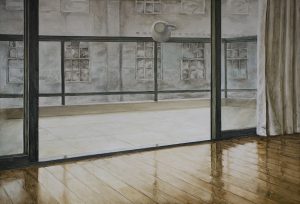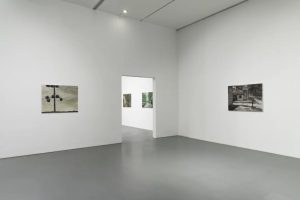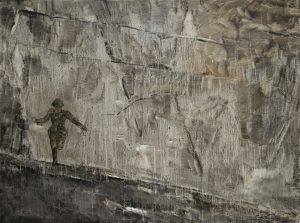Zhou Zixi on His Painting and Exhibition
Zhou Zixi’s solo exhibition at the Shanghai Baolong Art Museum — The Longing Evoked from Afar Is Not a Call Toward the Unknown, but a Summons to Return Home — features more than seventy works that trace nearly two decades of the artist’s practice, revealing multiple layers shaped by different historical contexts since the late 1990s.
Rather than following a chronological order, the exhibition unfolds across five chapters — Childhood, Landscape, Dwelling, Dream, and The Tilt of the Standing Pillar — like fragments of memory flashing unpredictably, forming a kind of “natural montage.” One might even imagine the entire exhibition as a single artwork, through which we glimpse the emotions, attitudes, bitterness, and absurdity that Zhou has long guarded. In this conversation, Zhou shares the origins of his practice, the conception of this exhibition, and his understanding of painting.

After Noon 02,2021,Oil on canvas,150 x 220 cm
I first studied Chinese literature, entering university in 1988. One summer in my second year, I happened to visit a friend’s studio and joined them in painting. A month later, I found it so fascinating that by the end of August I had submitted my withdrawal letter and switched to art. Three years later, I was admitted to the Art Department at East China Normal University. I studied there for two years, but was expelled for cheating in an exam.
In my creative journey, there were two pivotal moments.The first was entering East China Normal University, which gave me many opportunities to encounter contemporary art. By my sophomore year, I attempted my first performance work. In the summer of 1993, I was inspired by a performance by artist Zhu Fadong in Kunming — he had posted “missing person” notices for himself in both Beijing and Kunming. I felt the idea could be pushed further, so when the new semester began I invited four classmates to join me. Each day on campus we posted a missing-person notice for one of them. On the sixth day, we posted a notice in the name of our class searching for all five. A week later, we forged a court announcement declaring them missing, followed by a school notice expelling them for long-term absenteeism, and finally a notice stating that their search would be discontinued. The work drew intense pressure and threats from the school administration, which ironically matched the very premise we had set out to explore. It was one of my earliest expressions of the themes that still interest me today.
The second moment came in 1997, when Xu Zhen and I were renting in an urban village on the outskirts of Shanghai. When Yang Fudong came to the city, he stayed with me for a while. One day, he casually painted a landscape sketch that moved me deeply — that painting still hangs in my home. My exchanges with them at the time were hugely influential. Later, my experiments in photography and installation helped me gradually move beyond a purely painterly lens for thinking about painting. In other words, I began to see a work first as an artwork, and only then as a painting.

Zhou Zixi,“The Longing the Distant Worlds Aroused Spoke More to the Home Than to Anything Unknown”,Exhibition site,2021
People often joke that I am a “half-amateur” painter, because I never finished university and never mastered the academic painter’s language. But I have little interest in the formal language or technique of painting — for me, expression comes first. By expression, I don’t mean that I have an idea or a theory to communicate, but rather that I have many feelings I cannot put into words, and so I choose painting as the vehicle. The key question is whether your emotions — your perceptions, anger, or joy — are fully present on the canvas. For me, technique only matters insofar as it can render this fullness. Whether the approach is traditional or modern, academic or non-academic, is irrelevant.
Of course, looking back after so many years, I see that I may have developed my own language, one that is distinct from both the academic mainstream and current trends. When I stand before a canvas, my only aim is to paint it until I find it beautiful. Naturally, what I find beautiful may not appeal to others, but my own sense of beauty is enough. I often think: what is the most a good painter can do? At best, to expand the boundaries of aesthetic possibility. That is my own aspiration.
For this exhibition, curator Lu Mingjun selected several dozen works from over eight hundred, breaking them apart and recombining them. Although this logic differs from my own, it allowed me to see my work from another perspective and offered me new insights. The title of the exhibition comes from a short piece in Walter Benjamin’s Berlin Childhood around 1900. The word “home” in the title can certainly refer to family, hometown, or childhood in a literal sense, but I personally prefer to understand it in spiritual terms — as a “spiritual home” or, one might say, an “other shore.” In truth, all forms of creation — literature, music, painting — may at their core be the pursuit of some kind of other shore or homeland.

Xiaogang Grotto murals 029,2021,Oil on canvas,60 x 80cm
Most people who have seen my paintings feel that I depict suffering — even my landscapes seem imbued with melancholy. More than twenty years ago, friends advised me not to always paint in such a grim and solemn tone, but I feel comfortable only this way. Beyond that, I must admit I harbor deep concern for the world today. I often feel tense and uneasy, and I need to process these feelings — painting is one way I think through them, as well as a way to vent and release.
I have long been interested in history, politics, and literature, and looking at human civilization as a whole, the picture is largely pessimistic. I have always believed in the saying, “An individual’s suffering is the suffering of all humankind.” It may sound exaggerated, but it is in fact very real. If one person’s suffering remains unresolved, then logically the suffering of humanity remains unresolved — they are always connected.
Interview by Li Suchao
Source: Artforum China